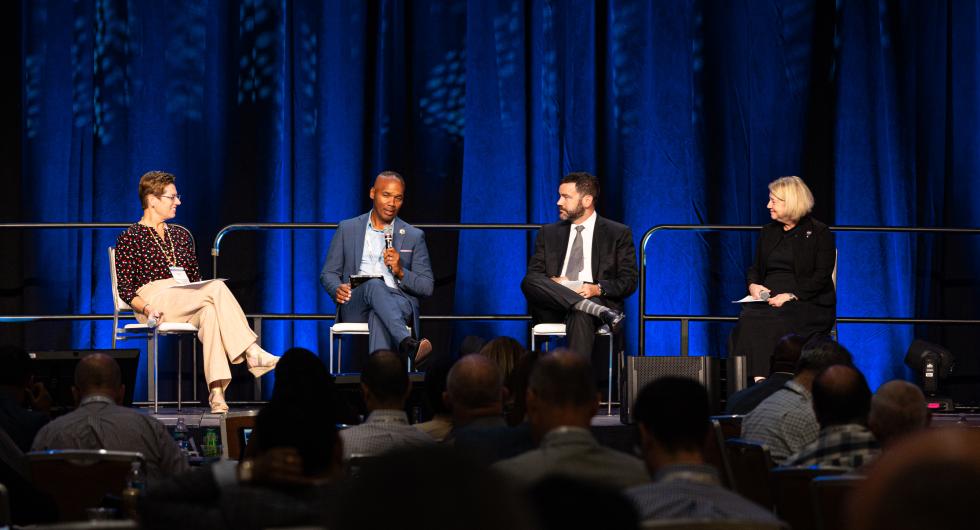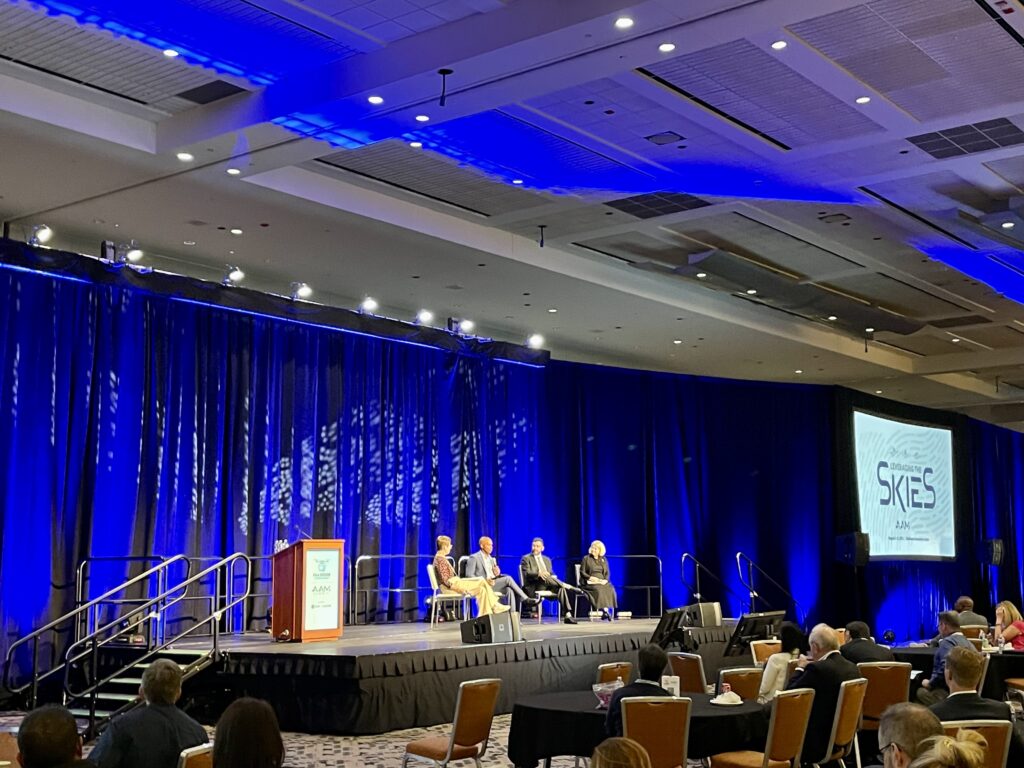Industry Experts Weigh In On Equity, Safety, and Efficiency in Advanced Air Mobility


A panel discussion at this week’s AAM Summit brings together industry experts who discuss the complexities, opportunities, and key challenges—including equity, safety, trust in autonomy, and global harmonization—that lie ahead in the evolution of advanced air mobility. (Photo: AUVSI)
BALTIMORE, Maryland —Delivery drones and passenger air taxis are set to take center stage in the advanced air mobility landscape. Yet, as we prepare for the next wave of advancements, pressing questions around equitable access are surfacing. At a panel discussion during the AAM Summit—presented by the FAA and AUVSI—speakers from NASA, UPS, and the Department of Transportation addressed the challenges of ensuring fair access to these emerging technologies.
Deputy Administrator at NASA, Pam Melroy; Vice President of Flight Operations and Safety at UPS, Houston Mills; and Undersecretary for Policy for the DOT, Carlos Monje, presented their insights on overcoming the equity barriers and paving the way for the widespread adoption and benefits of AAM.
In discussing what their organization is currently focused on regarding AAM, Houston Mills pointed to UPS’ partnership with Beta Technologies. In 2021, UPS announced plans to purchase electric vertical take-off and landing (eVTOL) aircraft from Beta. The companies are also collaborating on eVTOL testing in the UAE after a license was granted by the UAE government in March 2023.
UPS is leveraging its expansive global logistics network to explore practical applications of advanced air mobility technology, Mills explained. “As we look at this new technology, how we integrate it into our advanced global logistics network is very important,” he commented during the panel discussion.
Carlos Monje highlighted the FAA’s proactive efforts in providing leadership and guidance on aspects critical to the scale deployment of AAM, including building vertiports, establishing National Airspace System (NAS) protocols, and vehicle and pilot certification. “The FAA has been really sprinting in this area,” he said.
Monje also underscored DOT’s role, mandated by Congress, in developing a comprehensive strategy that looks at social and technical prerequisites for industry-wide deployment, in collaboration with interagency groups.
Pam Melroy pointed out NASA’s focus on fostering technological innovation in the aeronautics industry and the agency’s role in the AAM sector. “The first A in NASA is aeronautics, and we never forget that,” she said. She emphasized NASA’s efforts in building an industry community for dialogue, understanding industry needs, and addressing hard-to-solve problems.
Melroy further highlighted the importance of foundational technologies that would bolster the whole AAM ecosystem, citing uncrewed aircraft systems (UAS) traffic management, or UTM, as one of their “crown jewels.” In addition, she mentioned NASA’s work in areas like noise control and a “whole-of-government” approach to enable capabilities for their industry partners.

Colleen D’Alessandro, New England Regional Administrator for the FAA, moderated “The Future of Advanced Air Mobility” panel discussion. (Photo: Jessica Reed)
Equity can take on different meanings depending on context—for example, equity in the airspace versus equitable access to new AAM services. Carlos Monje discussed how to ensure that all of the stakeholders are talking about equity with the same understanding and are all working towards the same vision. “I think there’s a lot to learn here from previous tech that has been deployed in our transportation space,” he said, pointing to cars and trains as two examples.
Monje referenced the historical pattern of new technologies benefiting the elite before trickling down to the broader population, while often imposing negative impacts on specific communities. He advocated for intentionality to overcome this pattern and cited the technical complexities in ensuring equity in the adoption of AAM, including land use for vertiports, noise distribution, landside congestion, and workforce diversity. He also emphasized accessibility in terms of vehicle, vertiport, and payment method design, as well as competition to maintain affordable prices and high-quality services.
Pam Melroy shared her perspective on what the AAM industry and the federal government should be focused on now to enable the new sector. “It’s really critical, from a regulatory standpoint, that we allow innovation to thrive,” she said.
“At the same time, the government is responsible for the benefits to all Americans. So we have to take a very thoughtful approach to that. Achieving safe UAS integration is absolutely critical—it’s going to be the rising tide that floats all boats.”
Melroy mentioned that the industry has a responsibility to earn public trust through systems safety and engineering. She emphasized the need for lessons learned from other transportation systems to be applied in this new technological context.
Houston Mills touched on how new concepts in aviation such as third-party service providers and automation provide for—or even enhance—the level of safety of operations, as well as how new technology might enable the advancement of AAM. “One thing I’ve learned in this space is that the FAA’s mission is absolutely central, no matter what we do, as we advance with new technologies: safety and efficiency of the NAS have to remain at the forefront,” he said.
Mills remarked on the importance of making tactical and strategic recommendations for accelerating existing DOT and FAA activities. He also pointed out that there is a need for significant investments to fully realize AAM. This requires thoughtful planning and infrastructure development to ensure safety, efficiency, fuel savings, and reduced carbon emissions. Additionally, he emphasized the enormous potential of the sector to create jobs and opportunities.
The members of the panel discussion shared their thoughts on some of the main challenges in enabling the success of the AAM industry. Pam Melroy emphasized the complexity of integrating traditional aviation with uncrewed aircraft. She stated that this represents a considerable systems engineering challenge that requires equitable solutions for all stakeholders. “Trust in autonomy is important, and it has far-reaching impacts, as we’re seeing across other forms of transportation,” she added.
Carlos Monje identified the spectrum for ADS-B and VHF as a major challenge given its increasing demand and finite availability. He mentioned the role of the FCC in working towards more efficient spectrum use.
Another challenge he cited is operational resilience, particularly the ability to maintain service in poor weather conditions. “Especially if we’re talking about a distributed network of vertiports, you don’t want to put all that traffic back on the roadways at the same time—it’d be very bad for the system,” he explained. Monje also pointed out the crucial role of local governments in integrating land use planning and managing first and last-mile travel connections to support AAM operations.
Houston Mills sees harmonization as a key challenge. “The spectrum allocation becomes especially important in the realms of digital flight,” he said. “All the different users, both ground-based and air-based, are going to have to use the spectrum in order to enable an advanced technology environment for those operators.”
He underlined the importance of harmonization on local, federal, and international levels to ensure that everyone is using the same playbook. Mills also pointed out the need for standardized rules globally to facilitate the operation of AAM technologies worldwide. Finally, he noted the challenge of federal pre-emption for the FAA, indicating the necessity for a single voice in managing airspace to maintain safety and efficiency.
—————
Boost Internet Speed–
Free Business Hosting–
Free Email Account–
Dropcatch–
Free Secure Email–
Secure Email–
Cheap VOIP Calls–
Free Hosting–
Boost Inflight Wifi–
Premium Domains–
Free Domains





